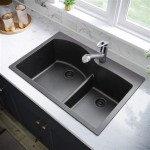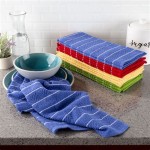Farmer Kitchen Sink: An Essential For Home Cooks Everywhere
The farmer sink, also frequently referred to as a farmhouse sink, has transitioned from a utilitarian fixture in rural kitchens to a highly sought-after element in modern homes. Its distinct design, characterized by an exposed front apron, offers both aesthetic appeal and practical advantages. The sink's functionality and visual prominence make it a focal point in any kitchen, contributing to both the room's overall style and the efficiency of culinary tasks.
Choosing a kitchen sink involves considering numerous factors, including size, material, installation method, and overall design. The farmer sink distinguishes itself from other sink types through its unique apron-front design, providing a visual statement and functional benefits not found in traditional under-mount or drop-in sinks. This article delves into the key aspects of the farmer kitchen sink, highlighting its advantages, considerations for installation, material options, and its enduring appeal for home cooks.
Key Characteristics and Advantages of Farmer Sinks
The defining characteristic of a farmer sink is its exposed front apron. This apron, which extends slightly beyond the base cabinets, is not only aesthetically pleasing but also serves a practical purpose. The design typically eliminates the narrow strip of countertop that normally sits in front of the sink, bringing the user closer to the basin. This closer proximity can potentially reduce strain on the back and neck as the user doesn't have to reach as far forward while washing dishes or preparing food.
Another key advantage of farmer sinks is their generous size. Compared to standard sinks, farmer sinks tend to be deeper and wider, providing ample space for handling large pots, pans, and bulky items. This extra capacity simplifies the task of cleaning up after cooking, making it easier to soak oversized dishes and wash produce without cluttering the countertop. The increased volume also proves useful for multi-tasking, enabling users to wash dishes on one side of the sink while using the other for food preparation.
Beyond their practical benefits, farmer sinks contribute significantly to the overall aesthetic of the kitchen. Their timeless design complements a variety of kitchen styles, from traditional farmhouse to contemporary modern. The exposed apron-front becomes a focal point, adding a touch of character and sophistication to the space. The availability of various materials, finishes, and decorative details allows homeowners to customize their farmer sink to perfectly match their individual taste and the overall design scheme of their kitchen.
Considerations for Installation and Compatibility
Installing a farmer sink differs from installing standard sinks, requiring careful planning and precise measurements. The sink's size and weight necessitate reinforced cabinetry to provide adequate support. The existing base cabinet often needs modification to accommodate the apron front, ensuring a seamless and secure fit. Consulting with a qualified contractor or plumber is highly recommended during the installation process to avoid potential problems and ensure proper functionality.
Compatibility with existing countertops is another crucial consideration. Due to the sink's exposed front, the countertop must be cut and finished to perfectly align with the apron. This requires precise measurements and meticulous workmanship to achieve a clean and professional look. The type of countertop material also plays a role in the installation process. Solid surface countertops like granite or quartz are generally more suitable for farmer sinks due to their durability and resistance to moisture. Laminate countertops may require additional sealing to prevent water damage around the sink edges.
Furthermore, the plumbing configuration may need adjustments to accommodate the deeper basin of a farmer sink. The drainpipe and water supply lines may need to be repositioned to align properly with the sink's drain opening and faucet connections. Planning for these adjustments during the initial design phase can help avoid costly complications and delays during installation. It is essential to consider the height of the faucet in relation to the sink depth to prevent splashing and ensure comfortable use. A taller faucet with a pull-down sprayer is often recommended for farmer sinks to facilitate easy cleaning and filling of large pots.
Material Options and Durability
Farmer sinks are available in a diverse range of materials, each offering unique aesthetic and functional characteristics. Fireclay, stainless steel, cast iron, and copper are among the most popular choices. Fireclay sinks are renowned for their durability, scratch resistance, and classic farmhouse appeal. The high-firing process gives them a non-porous surface that is easy to clean and resistant to stains. Stainless steel sinks are known for their hygienic properties, corrosion resistance, and modern look. They are a practical choice for busy kitchens due to their ease of maintenance and affordability.
Cast iron sinks, typically coated with a porcelain enamel finish, offer exceptional durability and heat resistance. The porcelain enamel provides a smooth, glossy surface that is resistant to scratches and stains. However, cast iron sinks are considerably heavier than other types, requiring robust cabinet support. Copper sinks offer a distinctive rustic aesthetic, with their warm hues and natural patina. Copper is naturally antimicrobial, making it a hygienic choice for the kitchen. However, copper sinks require special care to maintain their appearance and prevent tarnishing.
The choice of material significantly impacts the sink's longevity and ease of maintenance. Fireclay and stainless steel are generally regarded as the most durable and low-maintenance options, while cast iron and copper require more diligent care to preserve their appearance. Understanding the properties of each material and considering the specific needs of the kitchen is essential for selecting a farmer sink that will provide years of reliable service. Factors such as daily usage, cleaning habits, and aesthetic preferences should all be taken into account when making the final decision.

Farmhouse Sinks Why This Craze Isn T Worth The Hype
:max_bytes(150000):strip_icc()/concrete-sink-wayfair-695a50575c1d4431a0c0d52b2e078174.jpg?strip=all)
Concrete Farmhouse Sinks Are Getting A Makeover

What Is A Farmhouse Kitchen Modern Design And Decor Bauformat Seattle

Corner Sinks What To Consider We Chose At Home In Love

28 Kitchen Essentials For The Home Cook Turntable

Kitchen Sink Ideas To Inspire Your Next Renovation Home Beautiful

42 Best Kitchen Sinks 2024

Standard Kitchen Sink Dimensions And Sizes In 2024

The Ultimate Guide To Sinks For Your Home Vevano

Bocchi Contempo Farmhouse Apron Front Fireclay 33 In Single Bowl Kitchen Sink With Bottom Grid And Strainer White 1352 001 0120 The Home Depot
Related Posts








